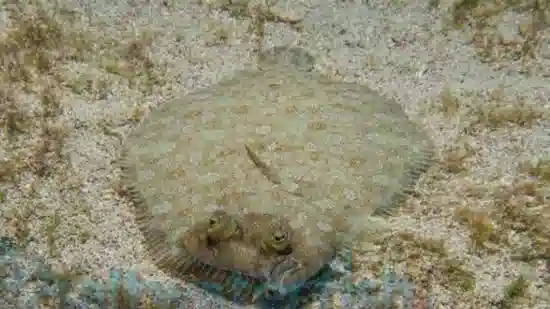Flounder: Assorted - Eastern Asia
Bothus sp.
(1 Reviews)

Flounder: Assorted - Eastern Asia
Bothus sp.
(1 Reviews)
{{ item.name }}
Size: {{ item.extra_field_3 }}
${{ getFormattedPrice(item.saleprice) }} ${{ getFormattedPrice(item.price) }}
To join the waiting list, click here
Free Shipping
With
$199.00
or more in Marine Life.
More details...
Flounder: Assorted - Eastern Asia Care Facts
| Care Level: | Moderate |
|---|---|
| Temperament: | Peaceful |
| Diet: | Carnivore |
| Origin: | Indo-Pacific Ocean |
| Acclimation Time: | 3+ hours |
| Reef Safe: | No |
| Minimum Tank Size: | 150 gallons |
| Max Size: | 12 inches |
The Flounder (Bothus sp.) are found among the Indo-Pacific Ocean, where they hide among sand and substrate awaiting prey. They are peaceful towards other large fish, though may try to eat smaller ones. They should be kept in a fish only tank with plenty of sand to bury in. Their diets consists of small pieces of fish, mysis or krill. Flounders can reach sizes of 12+ inches, though this is less common in captivity.
The Flounder: A Unique and Engaging Addition to Your Marine Aquarium
The Flounder (Bothus sp.) is a fascinating addition to saltwater marine aquariums, offering enthusiasts a unique and engaging experience. This species, known for its distinct characteristics, requires specific care to thrive in captivity. This educational and formal product description delves into various aspects of keeping the Flounder, covering habitat, reef safety, size, lifespan, diet, aquaculture availability, compatibility, sexual dimorphism, coloration changes, temperament, tank requirements, and water conditions.
Habitat: Adapting to Sandy and Muddy Substrates
The Flounder originates from various marine environments, adapting to sandy and muddy substrates. This flatfish is commonly found in tropical and subtropical waters, showcasing its ability to blend seamlessly with its surroundings.
Reef Safety: A Bottom-Dwelling Companion
The Flounder is generally considered reef-safe regarding reef aquariums. Its bottom-dwelling nature and minimal interaction with coral make it suitable for reef enthusiasts.
Size and Lifespan: Moderately Sized Companions
These flounders exhibit a moderate size, reaching up to a maximum of X inches in captivity. They can live for several years with proper care, providing enthusiasts with a long-term companion in their marine setup.
Diet in Captivity: Carnivorous Preferences
Feeding the Flounder is relatively straightforward. They are carnivorous, with a preference for small crustaceans and live foods. A well-balanced diet, including high-quality flake and pellet foods and occasional live or frozen offerings, ensures their nutritional needs are met.
Aquaculture and Availability: Sustainable Practices
Aquacultured Flounder are available to hobbyists, contributing to sustainable and responsible aquarium practices. This availability promotes conservation efforts and reduces the impact on wild populations.
Compatibility: Peaceful Nature
The Flounder is known for its peaceful temperament, making it compatible with various tank mates. However, caution should be exercised when selecting companions to ensure they share similar environmental requirements.
Sexual Dimorphism: Minimal Distinctions
Distinguishing between male and female Flounder can be challenging, as they exhibit minimal sexual dimorphism. Generally, males may be slightly smaller, but external characteristics are not prominent.
Juvenile to Adult Coloration Changes: An Evolving Palette
As juveniles, these flounders display a subtle coloration that may change as they mature. The evolution of coloration adds visual interest to the aquarium, making it an engaging species to observe over time.
Temperament: Calm and Non-Aggressive
The Flounder is known for its calm and non-aggressive nature. This makes it an excellent choice for community aquariums where peaceful cohabitation is essential.
Tank Requirements: Creating a Suitable Haven
Minimum Aquarium Size: To ensure the well-being of the Flounder, a minimum aquarium size of X gallons is recommended. The tank should have a sandy substrate to mimic its natural habitat. Adequate hiding spaces and gentle water flow enhance the overall environment. Water Conditions:
- pH: Maintain levels between X and X
- Salinity: Keep within the range of X to X
- Water Temperature: Maintain between X and X degrees Fahrenheit
- Moderate water flow within the aquarium.
Other Common Names: Diverse Identities
The Flounder may also be known by other common names, including X, Y, and Z.
Five Compatible Tank Mates:
- Lionfish (Pterois spp.)
- Triggerfish (Balistidae family)
- Hawkfish (Cirrhitidae family)
- Pufferfish (Tetraodontidae family)
- Wrasse (Labridae family)
Why Choose the Flounder from Saltwaterfish.com: A Responsible Source
Saltwaterfish.com stands out as a reputable source for acquiring the Flounder. With a commitment to quality and sustainable practices, Saltwaterfish.com ensures that enthusiasts receive healthy and well-conditioned specimens. The assurance of aquacultured individuals adds to the appeal, aligning with the ethical considerations of responsible marine aquarium keeping. In conclusion, the Flounder is a captivating addition to saltwater marine aquariums, offering a blend of beauty and tranquility. With proper care, enthusiasts can enjoy this species' unique behaviors and visual appeal while contributing to the sustainability of the marine aquarium hobby. Consider the Flounder from Saltwaterfish.com for a reliable source of quality specimens and a fulfilling aquarium experience.
Precious and healthy, was eating ghost shrimp (live) in a day after arriving.
Reviewed by: Jennifer Axsmith on Feb. 19, 2024







